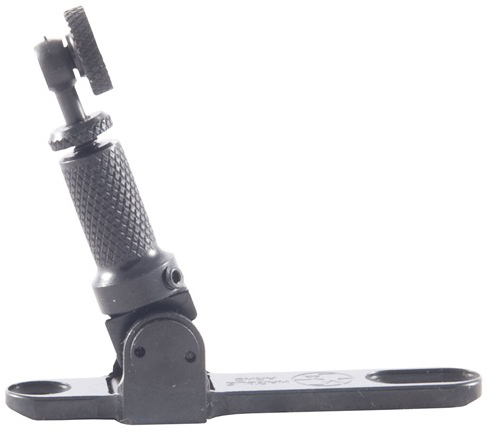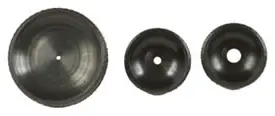|
Marble's Standard Peep Tang Sight By Chuck Hawks  Marble Arms (www.marblearms.com), "the leader in iron gun sights," has long offered tang mounted peep sights for lever action (and other) rifles. Before World War II, tang peep sights were highly regarded as very fast and highly accurate hunting rear sights and they were widely used by knowledgeable riflemen. As bolt action rifles, most of which do not have top tangs, eclipsed lever action rifles in popularity and optical sights eclipsed iron sights in general, peep sights (both receiver and tang mounted) fell into disuse. By the 1980's, they were seldom seen on a hunting rifle. Today, peep sights are making a modest comeback, spurred by the reproduction and reintroduction of some of the most famous and historical American lever and pump action rifles of the 19th Century. Most of these rifles are not designed for use with optical sights, so shooters wanting something better than the supplied open sights are rediscovering peep sights. A case in point is the new Winchester Model 1873 carbine recently reviewed by myself and the Guns and Shooting Online staff. This fine rifle is supplied with a traditional semi-buckhorn rear sight, which is one of the worst rear sight designs ever invented. These sights are slow to acquire, not very precise, block much of the area around the target from view and require great accommodation of the shooter's eye. This is not a sight you want on a hunting rifle. Since we intended to actually use our new Model 1873, we immediately started looking for a replacement rear sight. Some of us have used peep sights since the 1960's, so we knew this was the way to go. We had installed a Lyman No. 2 tang mounted peep sight on a previously reviewed Uberti Model 1873 replica and liked it. We wanted a similar sight for our new Winchester 1873. However, we had found the Lyman sight, which lacks a precise windage adjustment, a bit fussy and fragile, so we were up for experimenting with another brand. This brings us to the Marble's Peep Tang Sight that is the subject of this review. Here is how Marble Arms describes their Peep Tang Sight: "The Marble Arms� Peep Tang Sight is one of the cornerstones of our line. In the days when iron sights were the rule and scopes were the exception, the Peep Tang Sight was considered the top of the line in both precision shooting and general hunting. The increase in speed is due to the way your vision is drawn through the rear sight. You don�t have to acquire a sight picture. You are looking through the rear sight not at the rear sight. Just put the front sight where you want to shoot and squeeze the trigger. It�s the fastest sight combination for Cowboy Action Shooters. Webster Marble advocated a tang mounted peep sight on every hunting gun and called the Peep Tang Sight 'the perfect rear sight.' Once you use one, you will agree." "The Marble Arms� Peep Tang Sight is adjustable for windage and elevation. The adjustments are micrometer precise. Each firm detent click equals four-tenths of an inch movement at 100 yards." For our new Winchester/Miroku 1873 rifle, which is drilled and tapped for tang sights, we ordered a Marble's Peep Tang Sight #009832. This is the same sight used for the Cimarron and Uberti 1873's (except the Hunter model). This blued steel, folding rear sight is fingertip adjustable for windage and elevation. It perfectly fit the rifle's rear tang with its pre-drilled mounting holes. Before attempting to use the tang sight, remove the semi-buckhorn rear sight from the rifle's barrel by tapping it out of its dovetail from left to right. You can fill the dovetail with a blank or by substituting a folding leaf rear sight. Installation of the new peep sight was simply a matter of removing the plug screws from the rifle's tang and screwing down the Marble's rear sight. It works perfectly with the stock front sight. For rifles that must be drilled and tapped to receive a tang sight, complete mounting instructions are available on the Marble's web site. One word of caution: the sight's adjustments turn on tiny ball bearings; do not remove the "set" screws in the sight base or the loose bearings will fall out.  Specifications
The Marble's sight folds rearward to lie along the tang when not in use, out of harm's way. Upright for shooting, is feels solid and secure. Marble's first product was their Universal Rifle Sight, a tang mounted peep sight introduced in 1892 and marketed as an improvement over the established Lyman sight of the time. They have learned something about this type of sight in the last 120+ years and it shows. The sight is supplied with a standard, three disc, peep sight screw set allowing the use of small, medium and large peep sighting holes. For our eyes, we settled on the middle diameter rear peep screw disc. These interchangeable discs allow tuning the rear sight to the accommodation of your eye. The smaller the aperture, the greater your depth of field (like stopping down a camera lens) and the more precise your aim. The trade-off is less light reaching your eye. For a hunting rifle, use the largest diameter disc that allows you to see the front sight clearly. This gives you the widest practical field of view and maximum brightness.  The sight is click adjustable for windage and elevation. To adjust windage, you simply turn the windage adjustment knob clockwise to move right and counter-clockwise to move left. To adjust elevation, turn the elevation knob left to move up or right to move down. A lock collar is used to prevent elevation changes once the sight is set. Both adjustment knobs are knurled to facilitate gripping. Adjusting the sight is easy and precise. Testing the sight at the range, Guns and Shooting Online Chief Technical Advisor Jim Fleck, who had not previously used a tang mounted peep sight, was astounded that his 50 yard groups were as good with the Marble's peep sight as with a four power riflescope. (In addition to the Winchester '73, we also had a scoped Henry Big Boy at the range, both rifles chambered for the .357 Magnum cartridge.) Guns and Shooting Online Gunsmithing Editor Rocky Hays and I, having previous experience with tang mounted peep sights, managed to achieve similar results with the Winchester. One warning worth mentioning is that a tang mounted peep sight is close to the shooter's eye. This is an optical advantage, but if used on rifles generating heavy recoil, especially when shooting uphill and/or not holding the rifle securely, the sight can be driven back into the shooter's eye. This is not a problem with rimfire cartridges or the short centerfire rifle and revolver cartridges chambered in Winchester Models 1866, 1873 and 1892; Marlin Model 1894; Henry Original and Big Boy rifles. However, it is something to keep in mind. Of course, we recommend wearing shooting glasses to protect the eyes whenever firing any type of firearm. We all think highly of the Marble's Standard Peep Tang Sight. It is a precise, well made and confidence inspiring product that has become our first choice in this type of rear sight. |